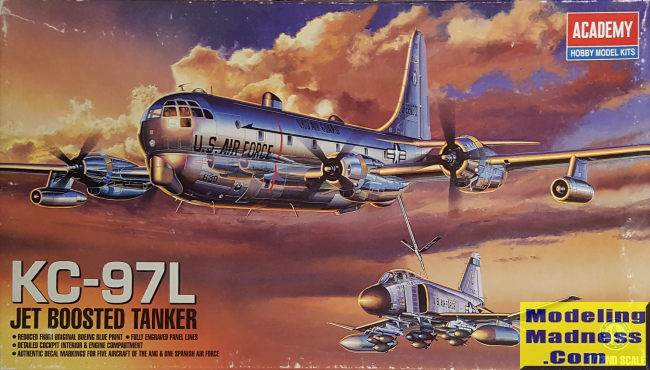
Academy 1/72 KC-97L
|
KIT # |
1606 |
|
PRICE: |
$55.00 |
|
DECALS: |
Six options |
|
REVIEWER: |
|
|
NOTES: |

|
HISTORY |
To say that Boeing has been in the business of building large,
multi-engined aircraft, would be stating the obvious. Starting with the XB-15 of
the mid 1930's and continuing today with the latest variant of the 747, Boeing
has managed to do well with both the civilian as well as the military market.
Probably this is because, in their early years, so many of their military
aircraft were used as the basis for successful civil airliners and vice
versa. With the C-97, it was the Model 377 civil version
that came second with the C-97 being based on the B-29. The later 377 was based on the B-50, which
was based on the B-29. Anyway, the USAF decided that it needed a long range
transport aircraft and had Boeing build a number of cargo/passenger C-97s. It
also saw the need for a dedicated tanker aircraft to replace the KB-29s that
were in service and so had Boeing design a tanker/cargo version, which became
the KC-97A. Both the C-97A and KC-97A were relatively short
production run aircraft. Improvements in systems and additional design
requirements to allow the KC-97 to carry more fuel resulted in several variants
of the KC-97. Those most built, were the KC-97G version with 592 examples built
in the early 1950s. These were placed into service with SAC for use in
refueling their long range B-50s and escort fighter wings, which were mostly
F-84Fs. However, a problem arose when the fast jet bombers
such as the B-47 and B-52s came on line. These aircraft were unable to fly slow
enough to properly refuel from the KC-97G. Two things helped improve the
situation. First, they started refueling 'downhill', so that the KC-97G could
fly faster. Secondly, most were modified to KC-97L variants with additional jet
engines under the wings to speed up the lumbering KC-97s. These versions were
all allocated to ANG tanker units as regular USAF units transitioned to the
KC-135, an aircraft that is still in service after over 50 years and looks like it is
good for another 20 or so!
|
THE KIT |
All of the parts are
crisply molded, including the B-50 bits. There is no flash and I couldn't see
any sink marks and other mold release pin marks. Those may become evident as the
kit is built, but a cursory look at some of the areas where they are most likely
(landing gear and alignment pins), showed no evidence of these flaws.
The
instruction sheet is written in the usual multiple languages with the standard
pictorial construction steps and international signs. There is a color chart
that gives just generic colors and not FS colors. There is also a parts diagram
that is numbered to help one find all the parts. One thing I can tell you from
my build of the KC-97G is that you'll need a lot of weight in the nose.
I'd like
to thank a friend in Korea for sending me this kit about fifteen years back so that I didn't have to pay
a fortune for it.
June 2020 Copyright ModelingMadness.com. All rights reserved. If you would like your product reviewed fairly and fairly quickly, please contact
the editor or see other details in the
Note to
Contributors. Academy is nothing if not frugal with its sprues. Many of the
sprues are from the B-50 kit, and the rest are from its KC-97G offering.
There are also a number of like sprues that are the same as with the 377 Stratocruiser and C-97A kit. What is unique to this kit
compared to all the others mentioned are the wing mounted jet pods.
An interesting adaptation is that the refueling blister is part of the
surrounding lower fuselage insert that replaces the cargo door of the C-97. This
part is molded entirely in clear plastic.
Academy is nothing if not frugal with its sprues. Many of the
sprues are from the B-50 kit, and the rest are from its KC-97G offering.
There are also a number of like sprues that are the same as with the 377 Stratocruiser and C-97A kit. What is unique to this kit
compared to all the others mentioned are the wing mounted jet pods.
An interesting adaptation is that the refueling blister is part of the
surrounding lower fuselage insert that replaces the cargo door of the C-97. This
part is molded entirely in clear plastic. The decal sheet is quite large and
very colorful. It gives markings for six aircraft. Five of them are Air National
Guard planes (Illinois, Wisconsin, Texas, Arizona, and Ohio) while the sixth one
is from the Spanish Air Force. The decal sheet looks very nice and is actually
quite large.
The decal sheet is quite large and
very colorful. It gives markings for six aircraft. Five of them are Air National
Guard planes (Illinois, Wisconsin, Texas, Arizona, and Ohio) while the sixth one
is from the Spanish Air Force. The decal sheet looks very nice and is actually
quite large.